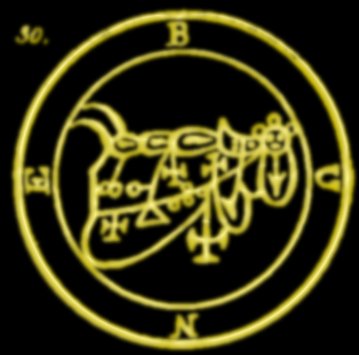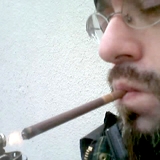Hell’s massive gate is a thing of legend — a mile high’s iron-bound iron with iron rivets nailing iron sheets to iron planks, and above all the famous legend, Abandon Hope All Ye Yadda Yadda Yadda. The iron gate is deep set in a stone wall as thick as a mountain, and it is a gate whose job is, famously, to make a big show of remaining closed.
Next to the unspeakably massive gate, maybe ten yards away, is an eight-foot-high glass double-door with matching chromed tube-steel vertical handles and a black-paint-on-chrome sticker next to each handle that says, “PULL”. Next to the PULL sticker on the left, farther left, is a cellophane-taped piece of typing paper on which is hand-written the ubiquitous notice, in fat black marker, “USE OTHER DOOR”.
Above these doors is a fancy debossed plaque that reads, in large Roman serifs, “Visitor’s Entrance & Gift Shop”. Smaller, beneath it, but still debossed in fancy Roman serifs, “Restroom for Customer Use Only”.
It is well lit, by fluorescent lights flush with the ceiling, inside. The door on the right opens easily, whether pushed or pulled, making one wonder why the PULL on the door seems so emphatic. Maybe it is just there to keep the candidate for entry from standing there, hand on the handle, unsure and waffling with indecision.
Inside, the shop is arranged sensibly in sections. It is tidy. There is no dust or grime anywhere, and everything is in its place.
Prominent in the center of the shop is a refrigerated section with an enormous array of flowers and a selection of vases and ornate containers for display. The flowers are sorted by color, indigo to crimson, with larger and more ornate and expensive flowers toward the top of each refrigerated case, to the back, and smaller, simpler flowers toward the front. Within each color there is a range from dark through bright to pastel, and the selection is extensive.
To one side of the refrigerated section is a large array of sympathy cards in an astounding array of languages. To one end of the display, the languages get older and more pictographic. One’s eye is drawn, in particular, to a large black card, approximately A4-sized, printed in white cuneiform characters. If one’s Minoan Linear A is sufficient for accurate translation, the card says, roughly, “YOU KNOW WHAT YOU DID.”
Beyond the card display are the more usual gifts: soft toys representing the usual gamut of cuddlable vicious animals and humanoid dollies (including many cutesified demonic entities with twee pitchforks), boxed confections of numerous types from candied fruits to nougats and toffees to chocolates to boiled sweets and hard candies to salted nuts to gummies to chewing gum and mints, small items of jewelry. There are items of comfortable clothing: pajamas and robes and slippers, from the utilitarian and serviceable to soft toys you stuff your feet in. In a locking glass cabinet, there are cigars, cigarillos, and cigarettes.
There are no lighters, but one assumes that a handy source of flame would be fairly easy to find inside.
There is a selection of popular reading materials, including magazines and newsprint pads of puzzles and solitary games. All of the newspapers are current and neatly stacked. Cheaply printed and bound religious texts from every tradition are present.
In the rear of the shop is a cafe for the shop-weary, laid out automat-style. Vending machines provide the usual array of hot or cold non-alcoholic liquid refreshments, wrapped sandwiches, crisps and crackers, and sweets. White formica tables and stackable plastic chairs are arranged in an orderly fashion for use in a first-come, first serve basis. Each table has, dead center, a napkin dispenser and a basket of common condiments and salt and ground pepper and sweeteners for hot beverages.
The section closest to the checkout register is for souvenirs: hats and scarves and t-shirts and sweatshirts and nylon jackets emblazoned with the many names of Hell in a complete array of languages and religious traditions, many accompanied with commonly associated symbology. There are pens and keyrings and watch fobs and thimbles and collectible spoons. Here are the cheap plastic lighters missing from the tobacco case, covered in cartoon winking devils and coquettishly posed incubi and succubi, and a couple of the more expensive refillable kind, engraved with depictions of the massive iron gate.
There is a closed door in the wall beyond the checkout counter with a sign above it that reads “CHAPEL”.
A stand-up sign at the checkout counter reads “Now accepting applications for employment. Ask cashier for application.” The minotaur behind the counter notes with interest that one is reading this sign.
One lays down for purchase one’s choices:
The Minoan Linear A “YOU KNOW WHAT YOU DID” card.
A keyring bearing the name and text logo of Hell’s Gift Shop itself.
A knit cap bearing the logo of the Gehenna Gorgons roller derby team.
A Zippo-style lighter bearing a textured model of the Gate on the body and the legend “ABANDON HOPE ALL YE YADDA YADDA YADDA” on the lid.
The minotaur, in his Hell’s Gift Shop smock and apron, rings up the purchases professionally and accurately. He accepts payment and places all of the purchases in a commemorative plastic gift bag, with the register’s printed receipt, and one accepts the bag from his hands.
One pauses for a moment, facing the register, removes the “YOU KNOW WHAT YOU DID” card, and presents it to the cashier with a sly smile and a nod.
The minotaur sighs. He accepts the card gracefully and sets it, slightly open and standing upright, on his little work area behind the register. Next to, one notes, a carefully wound ball of twine and a pair of no-nonsense shears.
One nods again in companionable benediction, still smiling, and heads for the exit.
[*]






